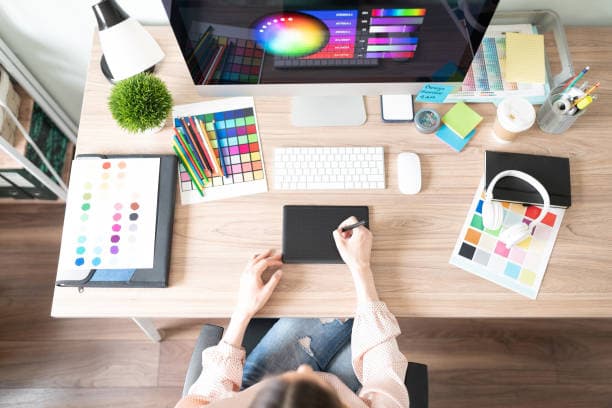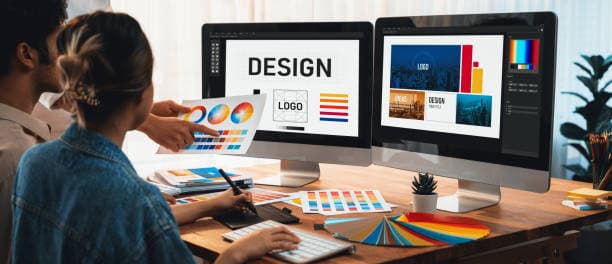In the world of graphic design, each coming year promises a new wave of inspiration, presenting a palette of fresh ideas and trends that shape the landscape of creativity and innovation. As we look ahead to 2024, we’ll encounter exciting trends, each a reflection of profound social change, advances in technology, and the pursuit of environmental sustainability that are having a marked impact on our society. Let’s examine the major themes that will influence graphic design in the upcoming year of 2024.
Rethinking the traditional: Mixing styles
In 2024, there is a significant shift in the realm of visual style towards rethinking traditional approaches and integrating them with innovative ideas. This pattern is particularly noticeable in two key aspects: the use of hybrid typefaces and the application of retro-modernist principles. Let’s look at each of these in more detail.
Hybrid fonts
Hybrid fonts are the epitome of boldness and innovation in typography, combining components drawn from several styles, eras and cultures. In 2024, these fonts are becoming the foundation for producing designs that can simultaneously evoke a sense of familiarity and novelty. This trend allows creators to try out letterform, structure and context, creating unique typefaces that can take a brand’s message to the next level.
Examples of hybrid fonts include combinations of serif and sans-serif styles, integrating calligraphy elements into modern design, and mixing geometric and natural forms. These fonts not only improve the visual appeal of the style, but also promote greater flexibility in its application, allowing it to adapt to different platforms and media while maintaining uniqueness & awareness of brands.
Retro-modernism
Retro-modernism in graphic design reflects the desire to return to classic, time-honored motifs, but with the application of modern technologies & approaches. In 2024, this trend is expressed through new interpretations of old ideas that combine the best of the past and present.
This can be seen in the integration of classic design elements such as retro fonts, pastel colors and abstract shapes that harmonize with modern effects such as gradients, shimmer and digital textures.This approach not only evokes a sense of nostalgia, but also gives projects a contemporary feel, making them more appealing to modern audiences.
The main advantage of retro modernism is its ability to create a deep emotional response in the viewer, combining familiarity with something new and unknown. This trend offers designers the opportunity to explore the historical legacy of visual culture, applying it in the context of modern technology and social trends.
Sustainability and eco-design
By 2024, eco-design and sustainability will have evolved from passing fads to being fundamental ideas guiding graphic design. The increasing desire for environmental awareness and the need to conserve the planet’s resources are pushing brands and companies to rethink their design approaches. This is shown in the selection of products, processes, and materials that reduce negative environmental impacts. Embracing sustainability in design not only emphasizes a brand’s social responsibility, but also opens up new opportunities for creativity, using eco-friendly materials and packaging as elements that add value and uniqueness to a product.
Artists are utilising green typography more often as an expressive tool in their efforts to create products that are more sustainable and kind to the environment. Fonts inspired by shapes found in nature, such as plants, water droplets and rocks, not only add visual interest and originality to a design, but also carry a deep ecological message. This trend is a reflection of designers’ desire to use nature’s beauty and individuality to communicate their message about how important it is to protect the environment. Consequently, green typography is emerging as a potent communication tool that highlights the significance of environmental sustainability in the modern world, in addition to being a stylish option.
Breakthroughs in the world of technology
Designing graphics is undergoing a revolution that is opening up new possibilities for creativity and interaction with the arrival of artificial intelligence (AI) and augmented reality (VR/AR) technologies in 2024.
Artificial intelligence is transforming approaches to design by generating layouts automatically and font selection, as well as offering personalized design solutions. AI may produce original graphics and images, allowing up designers to engage in more complex creative tasks.
Virtual and augmented reality bring the concepts of involvement and communication, allowing users to interact with virtual content or augment the real world with virtual elements. These technologies are expanding the possibilities for advertising, packaging and presentations, creating deep and engaging visual experiences.
As a result, the combination of AI with VR/AR and visual design substantially enhances the medium, making it more immersive, personalised, and interactive while also providing new avenues for communication between creators and consumers.

Social responsibility and inclusiveness
Two fundamental aspects that emphasize the importance of diversity and social responsibility in graphic design in 2024 are as follows:
Design for All:
- Developing content adapted to the needs of a wide range of users, including people with limitations.
- Prioritize accessibility: boost readability, make use of contrasting colours to improve the experience for those who are visually impaired, and design user-friendly interfaces for various forms of interaction.
- The aim is to create universal, combining aesthetic appeal with practicality for all users.
Minority Voices:
- Providing a platform to express and support diversity, equality and social justice through design.
- Making patterns that are indicative of & respect cultural diversity, support the struggle for human rights, and emphasize inclusion.
- Using design as a tool to promote social change and give voice to underrepresented groups.
These strands emphasize the role of graphic design as a powerful tool for creating a more accessible, diverse, and equitable society, affirming that design can and should serve as a force for positive social change.
In summary
As we look to 2024, we expect to encounter a new era in graphic design, where a mix of technological advancement, accountability for the environment, social inclusivity and creative reinterpretation of tradition promises to redefine not only the industry itself, but also its impact on society. This year will offer designers a rare chance to communicate with one another through the creation of meaningful, aesthetically pleasing work that can bring people together and advance lofty ideas. Graphic design will encourage us to think & act, offering innovative approaches to create a brighter and fairer future where every project is a step towards a better world.
